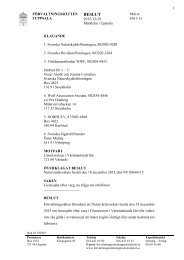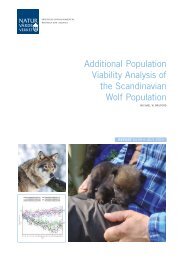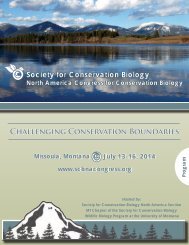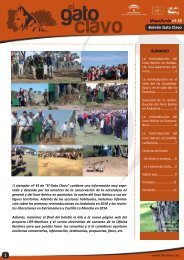1oC3Dbk
1oC3Dbk
1oC3Dbk
Create successful ePaper yourself
Turn your PDF publications into a flip-book with our unique Google optimized e-Paper software.
Seychellonema gerlachi. © Justin Gerlach<br />
Ramorinoa girolae, an endemic species of Western Argentina (distributed in<br />
the Provinces of La Rioja, San Luis and San Juan), provisionally assessed as<br />
Endangered. © Pablo Demaio<br />
policies.<br />
In 2013 we began contacting Provincial officials in Argentina.<br />
As a result of this enterprise, we completed the first workshop<br />
in July 2013, in the province of San Juan, assessing 53<br />
endemic species with the participation of local experts and the<br />
counseling of Dr Mariella Superina, Chair of the Anteater, Sloth<br />
and Armadillo Specialist Group, to whom we are very thankful.<br />
There is another workshop arranged for 2014 in the Province<br />
of San Luis, in which we plan to evaluate another 25 species.<br />
In parallel, we are interacting with local scientific<br />
institutions, trying to include the assessment of endemic<br />
species in scientific projects. The Specialist Group is formally<br />
involved in the project ‘Native plants of the centre of Argentina:<br />
diversity, uses and conservation’, led by staff scientists of the<br />
Botanical Museum of Córdoba (Herbarium acronym CORD). In<br />
this project, we plan to evaluate 269 endemic species<br />
distributed in the Provinces of Córdoba, Santiago del Estero<br />
and La Pampa.<br />
We would like to thank the government of the Province of<br />
San Juan for their generous financial support.<br />
Dr Pablo Demaio<br />
Chair, Temperate South American Plant Specialist Group<br />
Terrestrial and Freshwater Invertebrate Red<br />
List Authority<br />
The Terrestrial and Freshwater Invertebrate Red List Authority<br />
(TIRLA) has the remit of managing the Red Listing of all nonmarine<br />
invertebrates not covered by any Specialist Group.<br />
TIRLA’s remit covers at least a million described species and it<br />
currently has 73 members.<br />
In 2013 a new Cave Invertebrate Specialist Group was<br />
established. Discussions with hoverfly experts failed to result in<br />
any progress in forming a hoverfly group, but Red List groups<br />
within TIRLA were established for centipedes and millipedes,<br />
ants and South American tarantulas. It is hoped that in time<br />
these may develop into full Specialist Groups. These are only<br />
limited achievements and fall far from establishing the<br />
infrastructure needed. The failure to develop the necessary<br />
infrastructure is not due to a lack of experts or interest, but<br />
reflects the impossibility of allocating sufficient time to the task<br />
on a purely voluntary basis.<br />
Similarly, there has been progress in increasing the number<br />
of invertebrate assessments on The IUCN Red List, but this is<br />
mainly the result of a small number of highly focussed<br />
initiatives and does little to improve the diversity of invertebrate<br />
species on The IUCN Red List. Of the total of 454 TIRLA<br />
species added to the list, 315 were dung beetles assessed for<br />
the Dung Beetle Sampled Red List Index (SRLI), making good<br />
progress towards the 2014 target for that group. This is largely<br />
due to the great efforts of Monika Bohm in coordinating and<br />
checking these assessments. One cave spider and a single<br />
species of psyllid bug were also assessed. This represents a<br />
34% increase in assessed species since 2012, but is far from a<br />
representative sample.<br />
A major initiative for 2013 was the reassessment of 415<br />
species of non-marine invertebrate assessments dating from<br />
1996, almost all of which were assessed without data to<br />
support the allocated category. At the start of 2013 these<br />
represented just over 50% of non-marine invertebrate species<br />
on The IUCN Red List, making the accuracy of invertebrate<br />
data on the list highly questionable. These reassessments<br />
have proved challenging, in many cases no rationale for the<br />
1996 listing was ever provided and there is limited expertise<br />
available (and lack of interest) to reassess these taxa Following<br />
the development of the new Cave Invertebrate SG and plans to<br />
expand the scope of the Crab and Freshwater Crayfish SG<br />
some of the remaining species will no longer fall within TIRLA’s<br />
remit and will be reallocated. Of the species left in TIRLA’s<br />
remit, 23% have been reassessed.<br />
Progress towards making The IUCN Red List<br />
representative of biodiversity as described in the SSC strategic<br />
plan is currently extremely slow, and seems unlikely to be<br />
achieved on current rates of progress. At present a significant<br />
proportion of invertebrates on The Red List are individual<br />
assessments of species thought to be of concern, rather than<br />
comprehensive or sampled assessments, thus any data<br />
88 IUCN species Annual Report 2013






